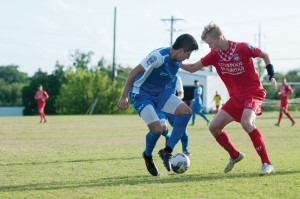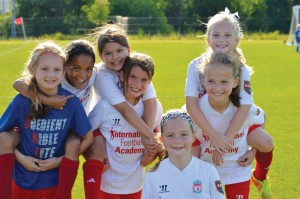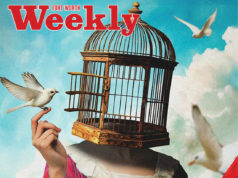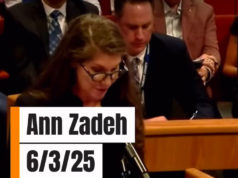
“In our international academies and soccer schools around the world, we provide opportunities for young players to play The Liverpool Way,” White said. “The way we do this is via an authentic training program which offers an all-around education for the young participants, helping to improve both their abilities on the pitch and their life skills off it.”
For Liverpool, the academies provide a way to stretch their global reach. The brand loyalty they build through grassroots marketing can translate into merchandise sales and eyeballs for sponsors. From a soccer perspective, it allows them to develop players who could one day contribute to their team on the pitch.
“These programs are about taking the club to the fans no matter how far they live away from Anfield,” White said. “It’s also about playing our part in the development of the game on a local level through both coach and player education.”
With exclusive rights to run Reds-affiliated clubs in the United States, LFCA already has operations in South Carolina and Florida in addition to five regions in Texas. And further expansion is on the way. Trevino said they’re currently talking to approximately 30 local clubs interested in signing up with Liverpool to “have a competitive edge in their particular market.”
LFC and LFCA vet prospective clubs based on factors like size of staff, facilities, and number of “A” licensed coaches, the top coaching level established by the United States Soccer Federation, which runs all organized soccer in America.
Liverpool-affiliated clubs are given access to proprietary “Boot Room” (the British phrase for locker room) insights and are expected to teach the game the way the parent club dictates.
The Liverpool Way dates back to 1892, when the club formed amid a dispute with the existing Everton FC club. (The two teams are still intracity derby rivals.) It adopted its city’s “liver bird” symbol as its own in 1901, the same year the team won its first league title. The first team had on-and-off success until the 1960s and 1970s, when the great manager Bill Shankly established a system that won multiple cups and league titles. Overall, Liverpool has won more European titles than any other English team and more league championships than all but Manchester United. Though recent years have seen the club garner less silverware, it has avoided relegation to lower leagues (which can happen in European sport) and regularly challenges for berths in European competitions. Its past successes could certainly add credibility to its sales pitch to prospective club players.
The team attracted the likes of Edvaldo Pedro, a central midfielder originally from the African country of Angola who speaks very good English. “I had played in [U.S. Soccer’s] Olympic development program for about five or six years, and I played freshman year at Lipscomb University in Tennessee,” he said.
He got on with Liverpool back when the team started four years ago when he was only 16 years old, earning a roster spot among some 200 players who tried out in Plano. “The regular playing time helps me compete. I just want to keep developing and eventually play professionally.”
The large and devoted fan base embraces tradition. “You’ll Never Walk Alone,” from the 1945 Rodgers and Hammerstein musical Carousel, was not only a hit in 1963 for Liverpool’s second most famous musical export, Gerry & The Pacemakers. The song also quickly became the team’s anthem. Fans sing it before every home game and often at other junctures as well. And The Kop, named for a historic Anfield terrace, has become a term used to mean the seating section, the club’s most devoted supporters, or even the club itself. “Team spirit, hard work, determination, and the ability to overcome any obstacles in life” are, according to the team’s promotional materials, the Reds’ core values, values that White wants taught wherever the Liverpool brand appears.
“Our international academy and soccer school programs are about delivering an authentic LFC experience, so what we’re actually striving for on a daily basis is consistency,” he said. “Whether we are working with a young player in Sweden, India, Egypt, Japan, or the U.S.A., the core coaching is always the same.”
Like most U.S. youth athletic clubs, Liverpool FC America runs boys and girls teams across a range of ages. The youth squads bear the names of Liverpool FC legends like Shankly, Keegan, and Dalglish. Liverpool insists on adherence to club tradition, such as social media silence on the anniversary of the infamous Hillsborough disaster, when 96 Liverpool fans lost their lives. To ensure students understand the full picture, the parent club takes a hands-on approach with its affiliates’ coaches.
“We provide ongoing technical support,” White said. “We send LFC coaches to work in situ, and we welcome coaches from the U.S.A. over to Liverpool for an intensive coach education program each year.”
LFCA coaches go to England annually.

“We sit down, and we see all the sessions about what is going on from the youth system to the top team,” Pelaez said.
Two LFCA academy players have already been to England for training. While it’s still a long shot that any LFCA player will end up on the Reds, he still knows that he will now be on the Premier League team’s radar.
“We just had two coaches from the U.K. that were here running camps and programs for us that attended Warriors games and were able to look at some of the boys,” Brody said. “So if they do want to consider possibly trying to pursue soccer at even a higher level than that, it’s a great bridge for them to be able to do that.”
Pelaez has also used connections from his days as a professional player to set up a trip to the continent to showcase his American players.
“Twenty-two players will be traveling to Europe, training over there, getting some friendly games, and being seen by the teams abroad,” he said. “If they’re good enough, probably some of them will get an offer to stay.”
He hopes interest in his players from overseas teams will also eventually translate into opportunities to represent their country in international competitions. The United States Soccer Federation runs national sides that range in age from under 14 to under 23. Pelaez specifically cited the under-18 and under-20 teams as the ones his players might work into if they gain playing time abroad.
An athletic club system, the primary developmental model in Europe, has different tiers of teams. They typically range from the youngest kids’ squads all the way up to a first team made up of professionals playing in one of the country’s top leagues. The Warriors are at the top of LFCA’s pyramid.
“It allows our kids a chance to play at a highly competitive level,” Brody said.
Eventually, the LFCA coaches and administrators want their No. 1 team to consist entirely of players who have come up through the LFCA system. Even now, though, a number of young up-and-comers appear in the regular lineup, some as young as 17. From a developmental perspective, having the Warriors helps LFCA determine how well they have coached and evaluated at the lower levels.
The Warriors team “is the highest level [in the American club’s structure], and it is always interesting to see how the final product works after you develop it,” Peleaz said. “You want to see if the job you did during all these years is the one that will be effective at the highest level, so you will know the truth by getting these players that you’ve been developing into the Warriors.”
The coach hopes the Warriors can offer up-and-coming academy players the chance to play against quality competition, as well as mix in LFCA graduates who have played at the college or pro levels.
The 2015 Warriors haven’t won a lot in the NPSL. Sitting in last place in the South Central Conference, 21 points behind first place Corinthians FC of San Antonio and 20 behind second-place FC Wichita, the team is still adjusting to the high level of play, Coach Peleaz said. After a loss Saturday to a Vaqueros side reduced to 10 men after their goalkeeper’s red card, Peleaz said he was less interested in scoreboards than developing his charges. Rather than keep his starters in throughout the game, he substituted frequently.
“I made [all] seven subs because to me, the NPSL is still a development league,” he said.
But this doesn’t mean winning is not important.
“If I was able to keep this group of young gentlemen for two or three years, it’s a fact that this group would become a champion within three years,” he said.
The Warriors ended up in Rough Rider Stadium thanks to a connection from an LFCA coach who also works for the Eagle Mountain-Saginaw school district. Trevino said the Warriors would likely remain at the facility next season, but they won’t play in Fort Worth forever. For one thing, the stadium sits within the Fort Worth Vaqueros’ territory. More importantly, an LFCA facility under construction in Carrollton will include a 1,000-seat stadium to supplement indoor and outdoor training fields.
Brody said he chose Carrollton after the city’s parks director approached him based on the Blue Sky Sports partnerships he had created with Allen, The Colony, and Keller. He decided it made sense to make the project Liverpool-branded and will house the LFCA offices there. The city will also add a retail component to the development.
“It’s a public-private partnership where the city actually leases us the dirt, and then we build the facility and operate it as a part of the Parks Department,” Brody said. “We still do have to pay some taxes on it.”
Training philosophies may help the club differentiate itself among customers who want to pay $2,500-$3,000 plus expenses yearly to advance their children’s soccer prospects. The Liverpool name may bring huge advantages when it comes to the academy side of its business. An international brand, however, faces different challenges in attracting paying spectators to fill a new stadium. A team like the Vaqueros has its home city in its name and a roster made up entirely of Fort Worth players. It offers a local pride appeal not easily available to a franchised product. To create a fan following, Pelaez believes LFCA’s approach on the training side will have to translate into on-field results.
Fans will come, he said, “if we do a good job developing all these kids, and they go to the Warriors, and we start getting the results we are looking for,” he said. “We have to show the market, especially here in the Metroplex, that we have the right way to develop players, and then the way we are going to show that is by the results of how these players are developing according to how many we get to the top universities or the professional level.”
With a stable location and some marketing, it seems logical that the Warriors might attract the portion of LFC’s massive global fan base that lives in this area. (Fort Worth and Dallas supporters clubs do exist.) If people do turn out to cheer on the team next season, they’ll see players wearing the official kit. The side had previously worn red Liverpooly garb manufactured by Warrior (hence the team nickname) but not the apparel actually worn by the first team in England.
“Liverpool did not allow anybody to wear the replica jersey officially,” Trevino said. “With the new five-year contract that we’ve just signed this past fall, they have allowed us to wear the replica jersey now. So it’s the first time in the club’s history that they’ve allowed a club outside of England to actually wear the replica.”
And the Warriors won’t be the only LFCA team dressed in red.
“We are the first group in the world that will wear the replica jerseys in our youth levels,” Pelaez said. “All the kids will be wearing the red replica just like the first team in England. That’s not happening anywhere else in the world.”
LFCA’s and LFC’s relationship continues to evolve. The parent club experienced a major change earlier this year when an iconic player left for the United States. White said the exposure for such a high-profile product of the Liverpool system could potentially benefit the U.S.-based club.
“Steven [Gerrard] is a fantastic role model for the young players on our programs around the world,” White said. “Having progressed through the club’s youth development system to go on and make such a significant contribution for club and country serves as a real inspiration for those just starting out in the game.”
When Gerrard takes the field against FC Dallas on Saturday, Aug. 15, at Toyota Stadium in Frisco, some lucky youngster associated with his old club’s U.S. affiliate will hold the legend’s hand and accompany him onto the field. Can Liverpool FC create a lasting presence in the area and the country? They have linked hands with LFCA to find out. l












Curious where the first image was acquired from? It is not the Warriors, but a U13 Liverpool D1 team that my son plays on. I took that photo. I was credentialed through a national sports wire for the Dallas Cup matches and all of my images were to be licensed through them. I own the copyright and do not have a problem with you using it for the article outside of the wire. However, I was never notified or asked for permission. If you’d like a link to the original file, please let me know.
Thanks.
Very interesting article on LiverpoolFC America. I’m a soccer parent who dri ves from the 817 to 972 constantly for games. Wish the story told more about other programs in North Texas. FCDallas has a youth development program. Dallas Texans has a partnership with Manchester United. Solar has a partnership with ChelseaFC. These local clubs have already produced players for the US MNT, MLS, and the Premier League.